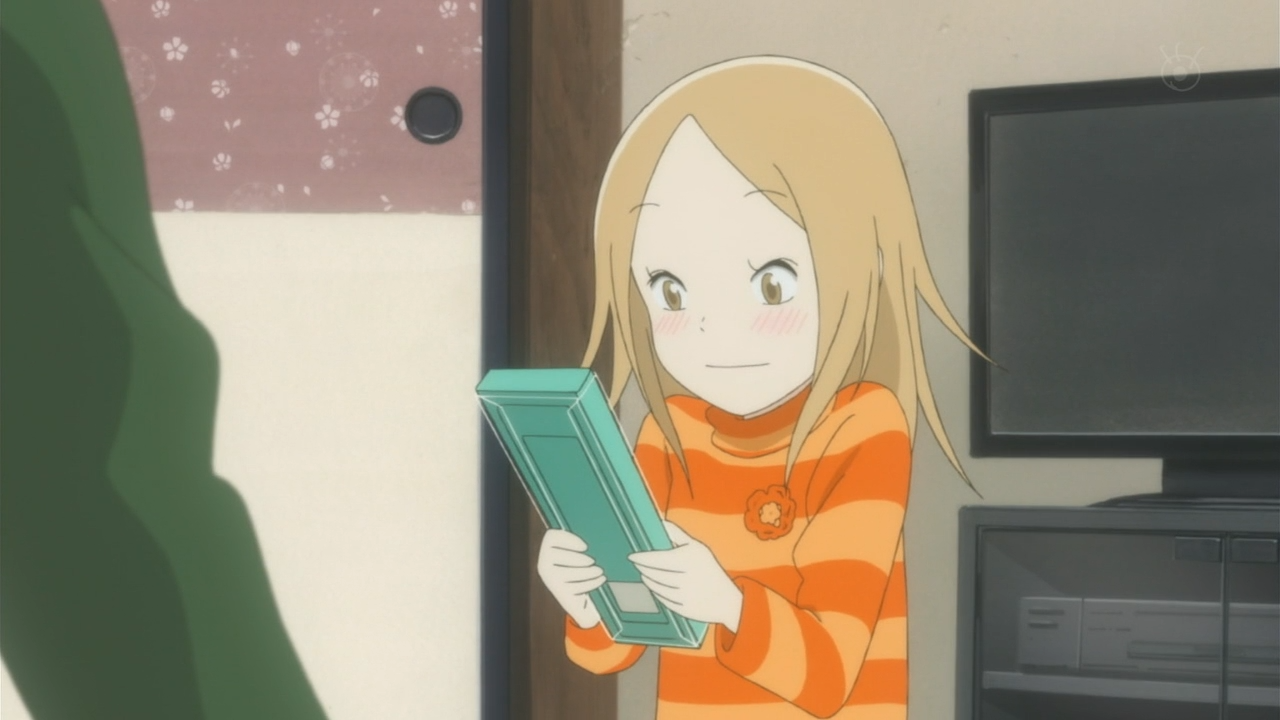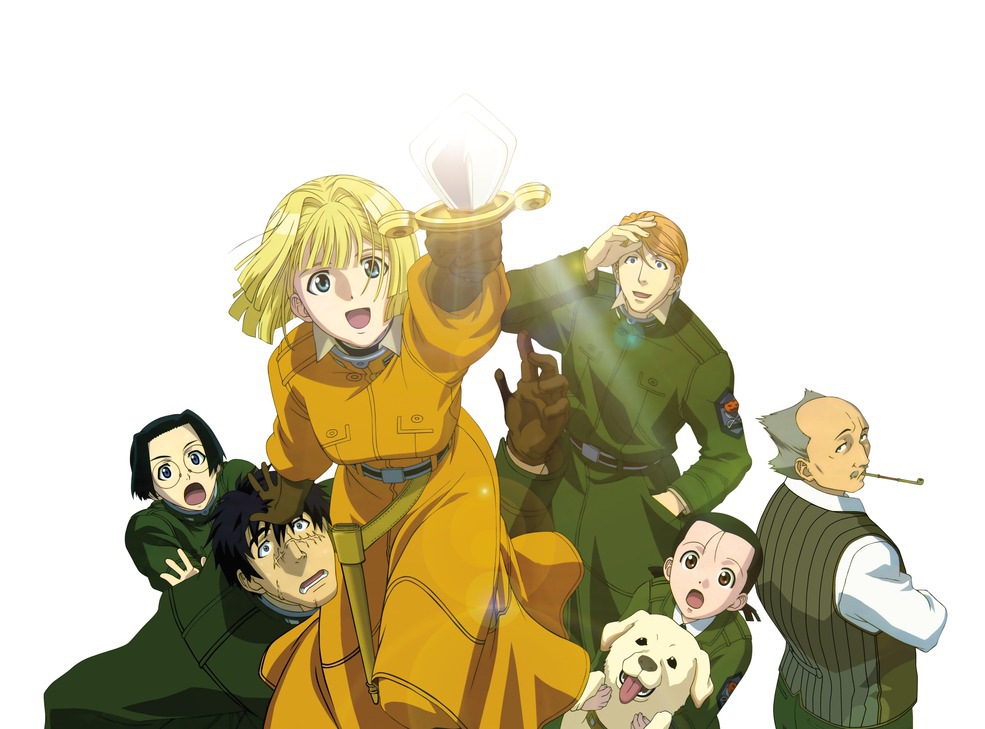

Quick Links:
The Slaughter: Vetting Anime for Broadcast
All television networks schedule their content, ostensibly in accordance with expected ratings. The segments of a single episode or film are scheduled much in the same way, each according to their expected impact. Some segments get moved up or back. Not every segment makes it on the air. One of the most interesting examples of content vetting in TV production is a little show that airs live every Saturday night from the building called "30 Rock" in New York City. Every week, Saturday Night Live production begins with little more than newspapers and ends with a complete sketch comedy show, the makeup for which is altered constantly on a bulletin board. Sketches live or die as index cards on the board, if they even manage to pass the laugh test.
In 2006, Aaron Sorkin took us behind the set of a fictional sketch comedy show called Studio 60 on the Sunset Strip. Each Friday night before going live, the fictional show's head writer and producer removed sketches from qualification by various means, e.g. throwing darts, or simply removing index cards from the board — an activity they dubbed, "the Friday night slaughter." Well, the name stuck with me, and now I'm turning it into a little anime activity, one which I may do myself or drag members of the staff in on.
Starting tonight and throughout the month of October, I plan to numb myself with sedatives and watch no more than four episodes (or the full duration, if a movie) of as many anime as possible. I will then assemble the winners in my own hypothetical program schedule, spanning an as-yet undetermined length. I'm going to be ruthless. I won't look kindly on shows that need their entire run to get anywhere — in fact, if a single episode that I watch doesn't manage to offer anything of value, then let's just say the show's standing will be in jeopardy. I will lavish praise upon shows that don't pander to me, and that treat me like an adult of at least moderate intelligence. I don't expect a single one to wow me, but if any do, I'll be sure to mention it.
How many shows will make the cut? Watch this space and find out!
Sora no Oto: Thumbs on Instrument
My first audio review sounds like a first audio review. Nonetheless, I hope you enjoy it. I think it fitting that the first title screened is one that sets the bar pretty high. (Hint, it makes the cut, barring a barrage of quality anime in my watch list.)
Star Dreck XVII: The Glass Fleet
The Glass Fleet dazzles us with mediocrity from the get-go — sparing much expense on class-project-grade CG space battles and effects, and a plot that lacks luster almost as much as it lusts to be lax. Why, it's almost as if the thing were produced by Gonzo. Oh. It was. Speaking of lust, the main characters do an awful lot of it toward each other, and they're all male. In a shocking inversion of anime misogyny, the more-masculine leads somehow lose their shirts in battle while the androgynous one, a fellow that goes by the Nomme de Machismo of Michel, watches in a paralyzed and bothered state. But he's mostly interested in the former royalty, Cleo, while the current Evil Emperor, Vetti, has the attentions of a young male servant named Ralph instead. Ralph symbolizes what people will want to do while watching this show.
You see, the whole thing starts when Michel is PMSing and decides to overthrow a couple space governments during a marriage ceremony. Perhaps he was unlucky in love, once, or perhaps he's just a bored NEET. At any rate, the military might of the Empire bears down on his less than adequate rebellion, and in true über-mensch fashion, he cries out for some other hero to get him out of this pickle. Cue the CG-glazed and royal-seal emblazoned Deus Ex Arcadia, piloted by a man who can be best described as...not Captain Harlock.
Meanwhile, Vetti lusts after Michel, due either to the latter's Barbie-esque physique, or his petty resistance to the long member of the law. In fact, the only thing that doesn't wreak of sexual tension is the aforementioned battle, which also starts in a bar. This much can be appreciated, despite neither lead losing teeth or singing drunken Irish songs afterward. (Yes, I realize that "drunken Irish" is redundant.)
Conclusion?
Warning: if you didn't grow up in the 80s, you may not be able to withstand the show's double-rainbow powers.
Full Metal Panic! Make me a Sandwich!
Unusually for me, my first experience with Full Metal Panic! was in manga form: Newtype USA ran it in their first few issues. Its premise is a bit of a yawn fest, to be honest. Child soldier extraordinaire Sosuke Sagara faces the biggest challenge of his professional career: high school. DUN DUN DUN~! After storied acts of badassery, his job is to babysit a teenager named Kaname Chidori, who is supposed to have powers of some sort, that is, other than being total jailbait. His ultra-serious approach to the task lands him in trouble with just about everyone — he's scolded by the teacher repeatedly for having a "toy weapon" on school grounds, and beaten and bruised by Chidori herself. He jokes that he might be killed by his charge before any of the bad guys show up.
Despite all the good things I've heard about the series, and even with the comic clips having left a good enough impression, I wasn't feeling it at the beginning of the show. Then something strange happened: the episodes flew by, one after another. The show is exceedingly careful about its pacing, and the right amount of ambitious in its writing, and it Just Works (TM). Kaname's annoyance at all the coincidental (as he says) attention from Sosuke is matched in kind with a morbid interest in the weirdo [stalker?]. Being a romantic comedy, the other characters and situations exist to nudge the two closer, but the show does its part in keeping us entertained in the process, instead of doing something stupid like making it all about the romance.
The plot barely gets going by the fourth episode, where a commercial jet carrying Chidori, Sagara, and a few hundred others gets hijacked and routed north. The episode provides a glimpse of what Full Metal Panic! is capable of — a ticking time bomb scenario, clear combat objectives, and yet, Kaname is taken and Sagara thinks of little but getting her back. This series is nothing I haven't seen before, and yet, I can think of little but seeing more.
The Frisbee of Relationships Past: Break Ups
On a lark, I decided to check out Break Ups, much for the same reason I checked out Time of Eve: it's short. At a quarter to midnight, it's rather easy to give up 15 minutes to try something different. And different it is. Hearing Korean when expecting Japanese does funny things to the brain, and in a way, the confusion paved the way for a rather enjoyable experience.
Break Ups begins during the act — we meet our newly-ex couple on a beach, battle weary and ready to end it for good. They find a washed up device in the sand that is not a hallucinogenic drug of some kind. The girl takes the disc-like device in hand and slams it into a rock...it doesn't break. When they both touch it, it whirls into action and starts transporting them to scenes from their multiple break-ups and back-togethers.
Brilliant, colorful background work and subtle intonation of melody drive the narrative as much as dialogue. By contrast the character work and character animation are plain...even cheap looking, but it's beautiful, in a way. We see their faces but don't learn their names, and their shared history speaks for them in living color. The device they found represents of course the cyclical nature of things, and after too short a time, we're back on the beach where we began. But this time, our two leads leave off a bit wiser than before. Cycles aren't so rigid as they sometimes seem, and maybe the lovebirds aren't either.
Violence..It's So Purty...: Canaan
Type Moon must hold a patent on masturbating audiences with visual arts. To get it, they would need to have run controlled experiments with otaku, figuring out the precise placement of mood music and pop fetishes and pseudo morality and deeply contrasting color schemes to put a stupid grin on subjects' faces. (The Lonely Island, eat your heart out.) The after effect is the same: "Well, that was pointless. But it felt good at the time."
Canaan, aside from being the name of the ancient region in the Middle East where, to be as precise as possible, shit went down repeatedly — it's also the name of our protagonist, a girl from a region described as much the same. She bears a tattoo on her left arm, coinciding with a similar one on the right arm of her dual, Alphard. Cue intense fighting, sparks flying... fly tying? Anyway, the other figure in play is Maria, a cute young photographer who smiles all the time to hide her apprehensions about all the bad things that keep happening to her, from getting attacked by hoodlums (only to be saved by Canaan) to a kidnapping and infection with a deadly virus.
Maria is an interesting character in the early episodes — perhaps the only one. She's clearly a wreck, but also a pro at rolling with the punches. Or perhaps it's more accurate to say that she runs toward the fire in full anticipation of being rescued by Canaan again. The show wastes no time in knocking her expectations down a notch, but not before the two reunite in ambiguously platonic fashion, and share some time in the sun with a big umbrella and giant sundaes. Stay tuned for the shocking revelation about how Maria's family is at the epicenter of the aforementioned rivalry!Once again, I'm in the position of not wanting to recommend a Type Moon production and also not wanting to stop watching. Dammit.
Kinky Robot Sex and the End of the World: Godannar
Godannar is a mecha show that shamelessly rips off Vandread of all things (which in turn probably ripped something else off), except it leaves out all the funny. In fact, its plot is a bit more like Evangelion, with a unique monster each week that all the sex hungry robots and their pilots have to figure out how to defeat. That wasn't a typo. The show goes to great lengths to make it look like the mecha are joining up in the most lewd fashion possible. You'd think it would be funny. It isn't.
The main character is Goh, who pilots a Dannar. Yup. Back in the war against mimetic beasts (who act like they're stuck in an invisible box all the time), Goh saved a girl named Anna, who swooned and wound up engaged to him. On their wedding day, one of the pesky monsters comes out of hiding and Goh rushes to the defense of Tokyo-3-or-whatever-the-city-is-called...without having said his vows. Royally pissed, Anna rushes toward the base, only to get sidetracked with a weapon blast and land in a cave housing a fruity pink robot, which of course she can pilot. Then something akin to her robot having sex with his robot happens, and by their powers combined, the monster is vanquished. Rinse. Repeat.
AIC tries really hard to do a regular mecha show, complete with godawful theme song (it rivals that of the original Macross). The Eva factor ruins any chances of that, though, and you start expecting at some point that the Godannar will belt out one of those "Beast that Cried I At the Heart of the World" roars with claws bared or whatever, and humanity liquefies into sticky orange goo just so some bratty kid can walk a beach in peace with his girlfriend. Then again, maybe not — the show does spend a lot of time bouncing boobs around for the audience.
Usagi Drop: Shit Just Got Real
Usagi Drop explores a theme so commonplace that I'm frankly shocked any anime studio picked it up. Production I.G. has, however, been known for producing works for bonafide adults at least as often as for forty year-old babies. On balance, I think they've done better than most, but I digress.
Based on the manga by Yumi Unita (available stateside from Yen Press), Bunny Drop is the story of Daikichi Kawachi, a single salaryman, and Rin, the six year-old illegitimate daughter of his newly-late grandfather. They meet when the family gathers for the old man's funeral, and she is visibly less standoffish around him than the others. Daikichi agrees to take care of his little ...aunt, and soon learns of the challenges of parenthood. His crazy work hours are the first hurdle, and there's the nagging question of what happened with the girl's mother.
Let me tell you, folks: this might be the feel-good series of the year. Rin is adorable, and Daikichi's sacrifices to provide her a home are something to admire. The two share a mutual respect for one another that is simply intoxicating. And because he took her in, a number of new experiences present themselves to him that might not have before, like meeting that attractive single mother at the nursery school....
I'd like to fill all of my virtual TV time slots with this show and call it a month, but alas, I press onward, in hopes of finding more anime worth watching.
Air, the Movie: When You Just Gotta Fly~
The Key/Visual Arts forté, if you will, is writing stories about young men who take advantage of vulnerable girls in the worst way. In Air, the girl is Misuzu Kamio, who has a debilitating disease that makes her weaker and more childish as it progresses. The unscrupulous bastard who takes advantage of her is Yukito Kunisaki, who makes a living as a schoolyard creeper who puts on puppet shows. (Don't worry: it's actually a puppet.)
Of course, if that was all there were too it, well, the show would still be popular among anime fans, but people like me wouldn't bother to write about it. There's an alternate plot going on — a period piece which Misuzu is researching for school. Kannabi no Mikoto is a winged being who lives in forced isolation from the humans. Forced as in: lots of soldiers with weapons make sure she won't escape. She falls for a samurai named Ryuuya — bummer for her, because she's also cursed, to suffer physically if she dares develop romantic ties. Not that that stops either of them, for what is life without suffering and death.
There are obvious parallels with the Yukito/Misuzu scenario, and it doesn't lack poetry, but it does beat you over the head with its book of poetry if it thinks you don't understand. Yukito is Mr. Not Involved, but forces beyond his control (i.e. "hormones") conspire to keep She and Him together. They start a band. They don't make music for very long.
Horizon in the Middle of the Bell Curve
I should know better than to choose a title just because somebody on Crunchyroll labeled it as science fiction. Horizon in the Middle of Nowhere is an incoherent post-apocalyptic mash-up of a bunch of genres that are apparently so overused by this point that they can no longer exist in isolation. Or maybe that's just in the future.
At some point, humanity gains power beyond all reckoning, and promptly uses it to make Earth uninhabitable...except for Japan, that is. People come back to Earth in spaceships only to find they can't leave, and as such, decide to reenact the history of the world as told in their holy volume of Testament. Little did they know that this meant lots of mayhem and death and chest pounding and invasions and burning cities. The once-indigenous Japanese literally float above it all in their city-ship called Musashi.The first few episodes treat us to the classwork of the Musashi Ariadust Academy, wherein students apparently learn how to miss their teacher with all manner of projectiles, magic, and melee attacks, only to be shown up by the class clown (and also class president), who grabs the unsuspecting instructor's chest. It only gets more silly from there, but it didn't strike me as an unbearable show. There's also some premonitions of bad things to come, noise about the written history coming to an end, and the prez makes overtures about asking out a girl who's been dead for a decade. I expect that the rest of the show will be similarly disjointed.
Mythical Detective Loki Ragnarok: Say That Ten Times Fast
This show answers the question: "What would the Grim Reaper be like if he were a midget?" You see, the great and powerful Odin banishes Loki, god of death, to a life of torments too great to enumerate. OK, fine, he runs a detective agency with assistant Ryuusuke Yamino, serving humans who have run-ins with supernatural elements. The horror! One such human is Mayura Daidouji, who lives in what looks like a dojo with father Daidouji, the latter of whom can see spirits while she can not.
She's trespassing in an old house when she encounters a doll that laughs in a creepy way and talks to her. Being very smart and in no way foolish, she brings the doll home with her, fascinated by it. The honeymoon doesn't last long. A black cat sneaks in like a ninja and makes off with Mayura's newfound prized possession. Wanting it back, she stops by the detective agency, where all four feet of Loki tunes in to the evil aura surrounding her. Events unfold, Loki undergoes a rock and roll revival of something resembling a magical girl transformation (without losing clothing, thankfully), and the world is set right for some period of time.This show is actually pretty good, and I feel bad for having let it languish in the slush pile of largely unsavory titles entrusted to Anime Dream by the late ADV Films. Mayura's enthusiasm is infectious, which all by itself is capable of keeping the show fresh and on track. (Of course she joins the agency, and of course she gets herself in trouble a lot.) Also, the plot doesn't waste any time in getting a move on, as various Norse gods appear wanting to kill Loki for various reasons. I look forward to seeing more...that is, if I could find more DVDs on the cheap, seeing as how I only have the first.
Bad Tank! No Jazz for You: Pumpkin Scissors
I managed, somehow, to watch two different postwar touchy-feely military misfits troupe shows in the same month. But who can't enjoy stuff like this? As Pumpkin Scissors opens, a long and bloody war comes to an abrupt close. We see surprise in the eyes of newly graduated officer Alice L. Malvin, and fade to the despondent expression of a man surveying the war-torn wasteland he helped create.
Fast forward three years, and Alice is 2nd Lieutenant in the Imperial Army State Section III "Pumpkin Scissors" unit, which is looked down upon by the rest of the military and civilians alike, as being nothing more than a propaganda tool. Their job is to survey areas hit hard by the war, and report back on what they find, as well as reassure the populace that relief is coming (except it probably isn't). Being the proud daughter of nobility, Alice is eager to make a bigger splash than her job description would indicate. On the first assignment we see her take, an ex soldier who commands a tank shows up and terrorizes a village, and she challenges him with nothing more than a short sword. In fact, she makes a declaration before all the townspeople that he is an impediment to the war relief effort and she will stop him.
Her bravery, or some might say stupidity, draws the attention of another ex soldier, Randel Oland, who just so happened to be part of the super-secret 901 Anti-Tank Trooper division — men who went on suicide marches against tanks and fired their special guns at point blank range. On the battlefield they were known as Gespenst Jäger: ghost hunters, for the blue lanterns that appeared to tank operators as Will o' the Wisps — to see them meant certain death. At the present time, Alice is in over her head, Oland helps defeat the bad guy, he joins the unit, and the process repeats throughout several episodes.
What's heartening about this show is how Alice and Oland affect each other over time: her eyes opening up a bit to the world around her, and his gradual feeling that he's part of something constructive. Similar growth happens in the other members of the unit, making for a show that balances wish fulfillment with a rather honest view of war's destruction and its lasting shadow over a people.











